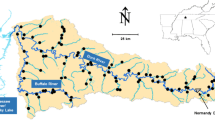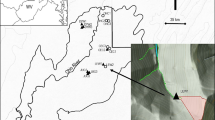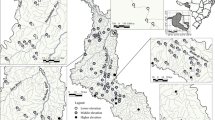Abstract
Aquatic ecoregions, based on regional landscape features, have been proposed as a model for aquatic resource management. The model assumes the existence of a typical biota associated with a given ecoregion and serves as the basis for biological assessment, reference site designation, and determination of stream potential, based on this biotic assemblage. Contrasting models for predicting stream ecosystem structure focus on the importance of local site conditions, including the regular and predictable changes that occur as a function of area draining to a site. In this study, a classification of 429 stream sites over an area of approximately 20 000 km2 in the St. Croix River basin delineated three major species groups: redhorse/spotfin shiner; brook charr/sculpin; and mixed species. Numerical analyses revealed no relationship between the species communities and ecoregions. In contrast, there was a strong association between the species communities and the area draining to the site. Our study highlights the importance of accommodating the inherent structure associated with site drainage area when imposing a regionally-based ecological classification upon stream ecosystems. This structure is expressed in the systematic changes to the physical habitat that occur with increasing drainage area and are reflected by the species community at the site. Management models that currently incorporate ecoregions in the classification or prediction of stream ecosystem structure would benefit from the inclusion of specific components that incorporate drainage area measurements.
Similar content being viewed by others
References cited
Becker, G. 1983. Fishes of Wisconsin. The University of Wisconsin Press, Madison. 1052 pp.
Crowley, J. 1967. Biogeography. Canadian Geographer 11: 312-326.
Hole, F. 1976. Soils of Wisconsin. The University of Wisconsin Press, Madison. 223 pp.
Huet, M. 1959. Profiles and biology of western European streams as related to fish management. Trans. Amer. Fish. Soc. 88: 155-163.
Hughes, R., D. Larsen & J. Omernik. 1986. Regional reference sites: a method for assessing stream potentials. Env. Manag. 10: 629-635.
Hughes, R., T. Whittier, C. Rohm & D. Larsen. 1990. A regional framework for establishing recovery criteria. Env. Manag. 14: 673-683.
Larsen, D., J. Omernik, R. Hughes, C. Rohm, T. Whittier, A. Kinney, A. Gallant & D. Dudley. 1987. Correspondence between spatial patterns in fish assemblages in Ohio streams and aquatic ecoregions. Env. Manag. 10: 815-828.
Leopold, L. & T. Maddock. 1953. The hydraulic geometry of stream channels and some physiographic implications. Professional Paper 252, United States Geological Survey. 57 pp.
Leopold, L., M. Wolman & J. Miller. 1964. Fluvial processes in geomorphology. W.H. Freeman and Company, San Francisco. 522 pp.
Lyons, J. 1996. Patterns in the species composition of fish assemblages among Wisconsin streams. Env. Biol. Fish. 45: 329-341.
Omernik, J. 1987. Ecoregions of the conterminous United States. Ann. Assoc. Amer. Geographers 77: 118-125.
Rohm, C., J Giese & C. Bennett. 1987. Evaluation of an aquatic ecoregion classification of streams in Arkansas. J. Freshw. Ecol. 4: 127-140.
Sheldon, A.L. 1968. Species diversity and longitudinal succession in stream fishes. Ecology 49: 193-198.
Threinen, C. & R. Poff. 1963. The geography of Wisconsin's trout streams. Trans. Wisconsin Acad. Sci. Arts. Lett. 52: 57-75.
Tonn, W., J. Magnuson, M. Rask & J. Toivonen. 1990. Intercontinental comparison of small-lake fish assemblages: the balance between local and regional processes. Amer. Nat. 136: 345-375.
Vannote R., G. Minshall, K. Cummins, J. Sedell & C. Cushing. 1980. The river continuum concept. Can. J. Fish. Aquat. Sci. 37: 130-137.
Waters, T.F. 1977. The streams and rivers of Minnesota. University of Minnesota Press, Minneapolis. 373 pp.
Winterbourn, M., J. Rounick & B. Cowie. 1981. Are New Zealand stream ecosystems really different? New Zealand J. Mar. Freshw. Res. 15: 321-328.
Wright, J.F., M.T. Furse & P.D. Armitage. 1993. RIVPACS — a technique for evaluating the biological quality of rivers in the U.K. European Water Pollution Control 3: 15-25.
Author information
Authors and Affiliations
Additional information
now at Environment Protection Authority
Rights and permissions
About this article
Cite this article
Newall, P.R., Magnuson, J.J. The Importance of Ecoregion Versus Drainage Area on Fish Distributions in the St. Croix River and its Wisconsin Tributaries. Environmental Biology of Fishes 55, 245–254 (1999). https://doi.org/10.1023/A:1007527800434
Issue Date:
DOI: https://doi.org/10.1023/A:1007527800434




